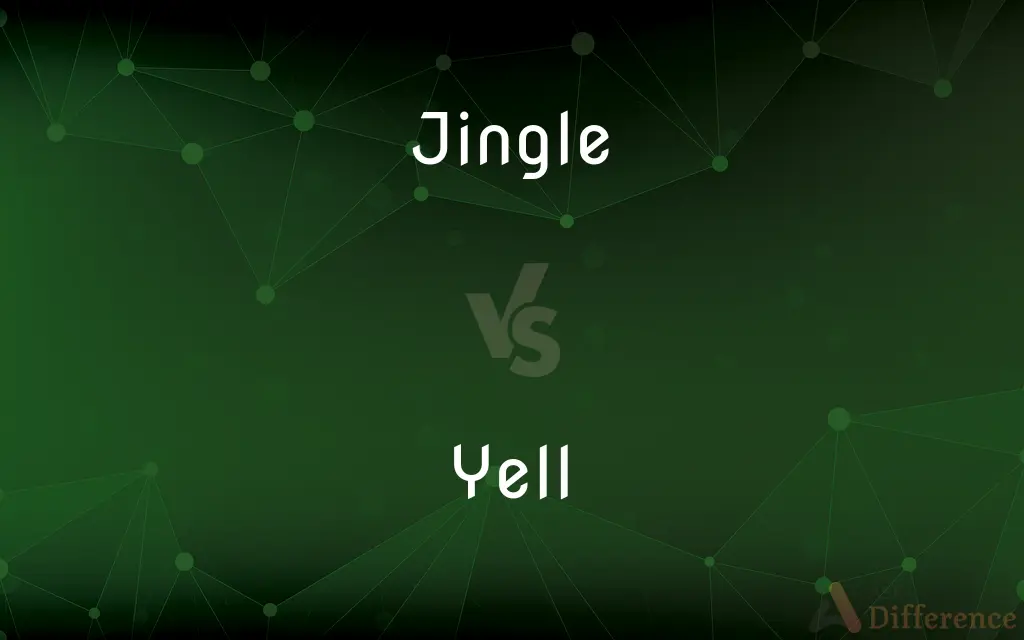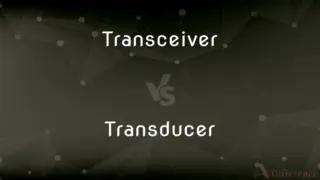Jingle vs. Yell — What's the Difference?
By Fiza Rafique & Urooj Arif — Updated on February 26, 2024
A jingle is a catchy, musical advertisement designed to be memorable, whereas a yell is a loud, often abrupt shout expressing strong emotion or calling for attention.

Difference Between Jingle and Yell
Table of Contents
ADVERTISEMENT
Key Differences
Jingles are crafted with melody and rhythm to promote products or services, embedding a brand's message in listeners' minds through music and lyrics. They are a creative marketing tool used in radio and TV commercials. Yells, in contrast, are vocal expressions that can convey excitement, fear, encouragement, or distress, depending on the context. They are spontaneous and can be found in various social and personal situations.
Jingles serve a commercial and persuasive purpose, aiming to influence consumer behavior, while yells are natural human reactions to immediate circumstances or emotions. Jingles are meticulously planned, composed, and produced, often involving professional musicians and singers. Yells, however, require no preparation and are a direct, unfiltered expression of the person's current state or intent.
The effectiveness of a jingle lies in its ability to be easily remembered and associated with a specific brand or product, enhancing marketing campaigns. The impact of a yell depends on its volume, tone, and context, influencing those within earshot in diverse ways, from alerting to motivating or even alarming.
Jingles and yells differ significantly in their social function. Jingles build brand identity and encourage purchases, contributing to the commercial landscape. Yells, however, play a role in communication and emotional expression among individuals, highlighting moments of intense feeling or urgent communication needs.
Despite their differences, both jingles and yells capture attention but do so for vastly different reasons and outcomes. Jingles aim for a lasting influence on consumer memory and behavior, while yells are immediate calls to action or expression.
ADVERTISEMENT
Comparison Chart
Purpose
Advertisement, brand recall
Express emotion, call for attention
Composition
Musical, with lyrics
Spontaneous vocal expression
Intention
Influence consumer behavior
Communicate urgency, emotion
Preparation
Professional composition and production
None required
Impact
Enhances brand identity, encourages sales
Influences immediate reactions or actions
Social Function
Marketing, commercial persuasion
Personal or group communication
Context
Radio, TV, and online advertisements
Varied social and personal situations
Compare with Definitions
Jingle
A short, catchy song or tune used in advertising.
The cereal's jingle became popular, making it easily recognizable.
Yell
A loud shout or cry expressing strong emotion.
He let out a yell of excitement when his team scored.
Jingle
Designed to be memorable and promote a product.
The jingle for the toy store is catchy enough to stick in your head all day.
Yell
Can express support or encouragement.
The crowd’s yells motivated the marathon runners to push through fatigue.
Jingle
Combines music with brand messages.
The insurance company’s jingle highlights its commitment to customer care.
Yell
A natural response to surprise or fear.
She couldn’t help but yell when she saw the spider.
Jingle
A marketing tool to enhance consumer recall.
Thanks to the catchy jingle, the phone number for the service is unforgettable.
Yell
Used to attract attention or convey urgency.
The lost hiker’s yell for help was heard by the rescue team.
Jingle
Often features slogans or taglines.
Their jingle ends with a catchy slogan that encapsulates the brand’s ethos.
Yell
Part of vocal expressions in sports and events.
The coach’s yell from the sidelines directed the players’ next move.
Jingle
A jingle is a short song or tune used in advertising and for other commercial uses. Jingles are a form of sound branding.
Yell
To cry out loudly, as in pain, fright, surprise, or enthusiasm.
Jingle
To make a tinkling or ringing metallic sound.
Yell
To utter or express with a loud cry.
Jingle
To have the catchy sound of a simple, repetitious rhyme or doggerel.
Yell
A loud cry; a shout.
Jingle
A catchy, often musical advertising slogan.
Yell
To tell someone off in a loud and angry manner.
Jingle
(intransitive) To make a noise of metal or glass clattering against itself.
The beads jingled as she walked.
Yell
A phrase to be shouted.
Jingle
To rhyme or sound with a jingling effect.
Yell
To utter or declare with a yell; to proclaim in a loud tone.
Jingle
To sound with a fine, sharp, rattling, clinking, or tinkling sound; as, sleigh bells jingle.
Yell
A loud utterance; often in protest or opposition;
The speaker was interrupted by loud cries from the rear of the audience
Jingle
To rhyme or sound with a jingling effect.
Yell
Utter a sudden loud cry;
She cried with pain when the doctor inserted the needle
I yelled to her from the window but she couldn't hear me
Jingle
A rattling, clinking, or tinkling sound, as of little bells or pieces of metal.
Jingle
A correspondence of sound in rhymes, especially when the verse has little merit;
Common Curiosities
Is yelling always negative?
No, yells can express a range of emotions, including positive ones like excitement and encouragement.
How long does a typical jingle last?
Jingles are usually short, often ranging from 5 to 30 seconds, to ensure they are easily remembered.
Do jingles work in all types of advertising?
While highly effective in audio and video mediums, jingles are not used in print advertising due to their musical nature.
Can anyone yell?
Yes, yelling is a natural vocal expression that everyone is capable of, though the context and reason for yelling can vary widely.
What’s the difference between a yell and a scream?
A yell is often louder and used for communication, while a scream might indicate fear or panic.
Can jingles become popular outside of advertising?
Yes, some jingles become so well-liked that they enter popular culture and can be remembered long after campaigns end.
What makes a jingle effective?
Its catchiness, memorability, and the clear connection to the brand or product it promotes.
How do marketers measure a jingle’s success?
Through consumer recall, increased brand awareness, and sales figures following the campaign.
Are there trends in jingle composition?
Yes, musical and lyrical trends in jingles often reflect broader musical styles and cultural sentiments.
Is it appropriate to yell in public spaces?
Context matters; yelling might be acceptable at a sports event but not in a quiet public setting.
Do all brands use jingles?
Not all, as some may prefer other marketing strategies, but jingles remain a popular choice for many due to their effectiveness in creating lasting brand impressions.
Can a yell be considered a form of expression?
Absolutely, as it can convey a wide range of emotions and intentions, from alarm to jubilation.
Can yelling be harmful?
Excessive yelling can strain vocal cords and might negatively affect interpersonal relationships if used inappropriately.
Why do people yell at sporting events?
To show support, motivate players, and share in the communal excitement of the game.
How has the use of jingles evolved with digital advertising?
Jingles have adapted to shorter, more focused formats for online platforms, maintaining their catchiness in even shorter snippets.
Share Your Discovery

Previous Comparison
Alicante vs. Benidorm
Next Comparison
Transceiver vs. TransducerAuthor Spotlight
Written by
Fiza RafiqueFiza Rafique is a skilled content writer at AskDifference.com, where she meticulously refines and enhances written pieces. Drawing from her vast editorial expertise, Fiza ensures clarity, accuracy, and precision in every article. Passionate about language, she continually seeks to elevate the quality of content for readers worldwide.
Co-written by
Urooj ArifUrooj is a skilled content writer at Ask Difference, known for her exceptional ability to simplify complex topics into engaging and informative content. With a passion for research and a flair for clear, concise writing, she consistently delivers articles that resonate with our diverse audience.
















































